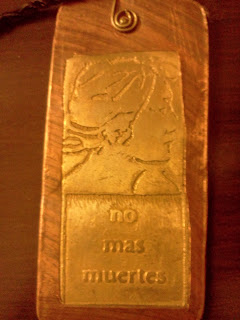No Mas Muertes
I bought this pendant from a booth in the exhibit hall at General Assembly today. This year the exhibit hall is different, in that they've invited some local groups to come and share their wares. This pendant benefits the Hogar de Esperanza y Paz (Home of Hope and Peace), which provides food for children, adult education classes, and children's camps. The Hogar Women's Cooperative makes these medallions. One of the artists was kind enough to tell me the story. I had her tell it to me twice on two different days (and bought a pendant each time), through an interpreter, to get some of the details, although I'm sure I've lost some of them already. The second time I asked about the process of making the medallions, which I was told on the first day is a two day process. After hearing all the many steps it takes to make these, I can see why it takes so long. It was really complicated, and I couldn't possibly repeat the information, unfortunately. I thanked her for the information, and with my limited Spanish explained that my husband is an artist, and would have many questions.
The woman pictured is Antonia. She was a young woman, and the mother of a young son--a toddler or infant. She didn't like having her picture taken, and so this is created from one of the only pictures of her as a young woman. She was from Central America (my memory is saying Guatemala, but I'm not positive) and walked across all of Mexico and into the Arizona desert. At some point, she couldn't keep up, and was left behind by the "coyote," the guide. When they found her body, her son was still alive, staying alive by licking the last of her tears. And this is all I know of Antonia's short story--all I know is this and her image on the medallion.
No mas muertes.
No mas muertes.
The woman pictured is Antonia. She was a young woman, and the mother of a young son--a toddler or infant. She didn't like having her picture taken, and so this is created from one of the only pictures of her as a young woman. She was from Central America (my memory is saying Guatemala, but I'm not positive) and walked across all of Mexico and into the Arizona desert. At some point, she couldn't keep up, and was left behind by the "coyote," the guide. When they found her body, her son was still alive, staying alive by licking the last of her tears. And this is all I know of Antonia's short story--all I know is this and her image on the medallion.
No mas muertes.
No mas muertes.

Comments